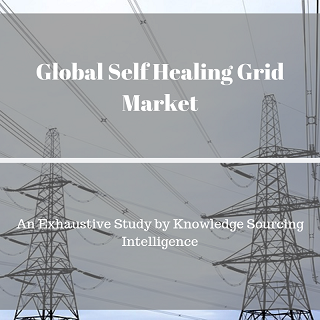Global Self healing grid market: Market Research by Knowledge Sourcing Intelligence
The Emerging Self
Healing Grid Market and Its Segment
Distribution and transmission systems are growing complex due to
the integration of conventional power sources such as thermal power and
non-conventional power sources including solar, wind, and hydro among others.
Self healing grids are essential and are in demand owing to higher reliability,
stability, and efficiency. Self healing grids establish communication with all
of its four components which include generation, transmission, distribution, and
consumers. The global self healing grid market is significantly driven by
increasing cyber attacks on national grids. Also, the ability to anticipate and
respond to system disturbances within limited time frame, is augmenting the
demand for self healing grids across all geographic regions. Moreover,
complexities in integrating different power sources such as solar, hydro, wind,
and tidal among others into a common grid, is heightening the market growth of
self healing grids across the globe. Furthermore, the market has ample of
opportunities in modernization of the traditional grid system prevailing in
most of the countries. However, lack of skilled workforce along with improper
electrical infrastructure will restrain the growth of self healing grid market
across the mentioned regions during the forecast period.
On the basis of application, self healing grid market is
bifurcated into power transmission and power distribution. The self healing grid market analysis shows
that both, transmission as well as distribution lines are the grid connected
entities. Transmission lines are responsible for exporting electricity from
generators to respective distribution networks. The distribution networks are
then liable to export electricity to all the associated consumers. The
exporting of the electricity is managed and controlled by the national grid.
On the basis of geography, self healing grid market is segmented
as North America, Europe, Middle East & Africa, Asia-Pacific, and South
America. North America holds significant self
healing grid market share owing to the early and rapid adoption of advanced
technologies and high investment made in the research and development. Asia
Pacific will experience the highest growth due to the increasing demand for
more reliable, stable, and efficient grid system. Increasing adoption of the
self healing grid systems in power sector will augment the growth for self healing grid market during the forecast period.
Competitive Landscape
Self healing grid market is highly competitive due to the
presence of well diversified international, and regional companies. Some big
international players dominate the market because of their brand image and
market reach. With high market growth rate and increase in demand, the sector
is attracting more players to enter into the market resulting in a more competitive
self healing grid market. The competitive landscape gives a need to change of
strategy and increase investment in order to boost up the presence, thereby
increasing the self healing grid market
size. The target market study done by Knowledge Sourcing Intelligence shows
that the key players of self healing grid market are ABB, Siemens AG, IBM,
General Electric Company, S&C Electric Company, CISCO, Eaton, Itron, and
Schneider Electric among others.
Key questions answered in
the report:
· What has been the performance of Self Healing Grid Market and
how it will perform in the future?
· What are the key players in the target market study?
· What are the various segments on which the market research is
conducted?
· What are the driving factors that are leading to the growth of
the market?
· What are the recent developments happening in the industry?




Comments
Post a Comment